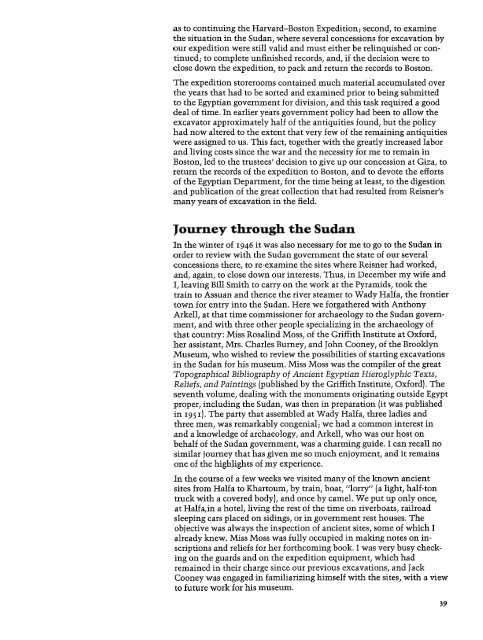Dows Dunham Recollections of an Egyptologist
Create successful ePaper yourself
Turn your PDF publications into a flip-book with our unique Google optimized e-Paper software.
as to continuing the Harvard-Boston Expedition ; second, to examine<br />
the situation in the Sud<strong>an</strong>, where several concessions for excavation by<br />
our expedition were still valid <strong>an</strong>d must either be relinquished or continued;<br />
to complete unfinished records, <strong>an</strong>d, if the decision were to<br />
close down the expedition, to pack <strong>an</strong>d return the records to Boston.<br />
The expedition storerooms contained much material accumulated over<br />
the years that had to be sorted <strong>an</strong>d examined prior to being submitted<br />
to the Egypti<strong>an</strong> government for division, <strong>an</strong>d this task required a good<br />
deal <strong>of</strong> time. In earlier years government policy had been to allow the<br />
excavator approximately half <strong>of</strong> the <strong>an</strong>tiquities found, but the policy<br />
had now altered to the extent that very few <strong>of</strong> the remaining <strong>an</strong>tiquities<br />
were assigned to us. This fact, together with the greatly increased labor<br />
<strong>an</strong>d living costs since the war <strong>an</strong>d the necessity for me to remain in<br />
Boston, led to the trustees’ decision to give up our concession at Giza, to<br />
return the records <strong>of</strong> the expedition to Boston, <strong>an</strong>d to devote the efforts<br />
<strong>of</strong> the Egypti<strong>an</strong> Department, for the time being at least, to the digestion<br />
<strong>an</strong>d publication <strong>of</strong> the great collection that had resulted from Reisner’s<br />
m<strong>an</strong>y years <strong>of</strong> excavation in the field.<br />
Journey through the Sud<strong>an</strong><br />
In the winter <strong>of</strong> 1946 it was also necessary for me to go to the Sud<strong>an</strong> in<br />
order to review with the Sud<strong>an</strong> government the state <strong>of</strong> our several<br />
concessions there, to re-examine the sites where Reisner had worked,<br />
<strong>an</strong>d, again, to close down our interests. Thus, in December my wife <strong>an</strong>d<br />
I, leaving Bill Smith to carry on the work at the Pyramids, took the<br />
train to Assu<strong>an</strong> <strong>an</strong>d thence the river steamer to Wady Halfa, the frontier<br />
town for entry into the Sud<strong>an</strong>. Here we forgathered with Anthony<br />
Arkell, at that time commissioner for archaeology to the Sud<strong>an</strong> government,<br />
<strong>an</strong>d with three other people specializing in the archaeology <strong>of</strong><br />
that country: Miss Rosalind MOSS, <strong>of</strong> the Griffith Institute at Oxford,<br />
her assist<strong>an</strong>t, Mrs. Charles Burney, <strong>an</strong>d John Cooney, <strong>of</strong> the Brooklyn<br />
Museum, who wished to review the possibilities <strong>of</strong> starting excavations<br />
in the Sud<strong>an</strong> for his museum. Miss Moss was the compiler <strong>of</strong> the great<br />
Topographical Bibliography <strong>of</strong> Ancient Egypti<strong>an</strong> Hieroglyphic Texts,<br />
Reliefs, <strong>an</strong>d Paintings (published by the Griffith Institute, Oxford). The<br />
seventh volume, dealing with the monuments originating outside Egypt<br />
proper, including the Sud<strong>an</strong>, was then in preparation (it was published<br />
in 195 I). The party that assembled at Wady Halfa, three ladies <strong>an</strong>d<br />
three men, was remarkably congenial ; we had a common interest in<br />
<strong>an</strong>d a knowledge <strong>of</strong> archaeology, <strong>an</strong>d Arkell, who was our host on<br />
behalf <strong>of</strong> the Sud<strong>an</strong> government, was a charming guide. I c<strong>an</strong> recall no<br />
similar journey that has given me so much enjoyment, <strong>an</strong>d it remains<br />
one <strong>of</strong> the highlights <strong>of</strong> my experience.<br />
In the course <strong>of</strong> a few weeks we visited m<strong>an</strong>y <strong>of</strong> the known <strong>an</strong>cient<br />
sites from Halfa to Khartoum, by train, boat, “lorry’, (a light, half-ton<br />
truck with a covered body), <strong>an</strong>d once by camel. We put up only once,<br />
at Halfa, in a hotel, living the rest <strong>of</strong> the time on riverboats, railroad<br />
sleeping cars placed on sidings, or in government rest houses. The<br />
objective was always the inspection <strong>of</strong> <strong>an</strong>cient sites, some <strong>of</strong> which I<br />
already knew. Miss Moss was fully occupied in making notes on inscriptions<br />
<strong>an</strong>d reliefs for her forthcoming book. I was very busy checking<br />
on the guards <strong>an</strong>d on the expedition equipment, which had<br />
remained in their charge since our previous excavations, <strong>an</strong>d Jack<br />
Cooney was engaged in familiarizing himself with the sites, with a view<br />
to future work for his museum.<br />
39

















